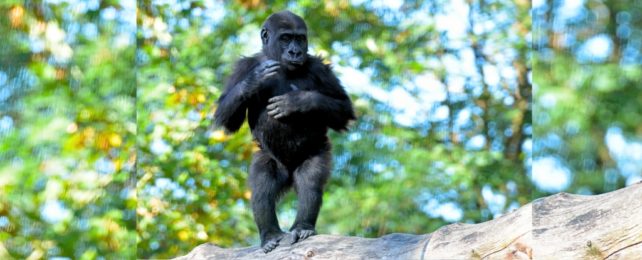Bipedalism – walking upright on two legs – is a defining feature of humans, thought to have developed in our ancient relatives as they crept away from the woodlands to take advantage of open spaces.
A new study exploring the behavior of wild chimpanzees suggests the evolution of bipedalism may in fact have been a strategy that first emerged while still moving about the branches of trees.
Researchers have long wondered if a change in habitat drove our ancestors towards bipedalism, or if they evolved the ability to walk on two feet to forage in the forests they'd long inhabited, a skill which later came in handy traversing the expanses of an open grassland.
"To date, the numerous hypotheses for the evolution of bipedalism share the idea that hominins (human ancestors) came down from the trees and walked upright on the ground, especially in more arid, open habitats that lacked tree cover," says biological anthropologist Fiona Stewart from University College London (UCL), who co-authored the study.
"Our data do not support that at all."
Using evidence preserved in bone structures, researchers can deduce how early hominins moved within particular environments. What the bones cannot say is how an environment may have directly influenced movement, or how a means of locomotion may have led to a change of scene.
Along with bonobos (Pan paniscus), chimpanzees are our closest living relatives. Understanding how their behavior varies in relation to habitat provides an exciting new insight into the ecological drivers of bipedalism that can otherwise only be inferred from fossil records.
Stewart and her colleagues state this is the "first test in a living ape of the hypothesis that wooded, savanna habitats were a catalyst for terrestrial bipedalism".
The study documented the behaviors of wild chimpanzees (Pan troglodytes schweinfurthii) in the Issa Valley, in western Tanzania. The Issa Valley is a savanna mosaic region in the East African Rift Valley, similar to the habitat where early hominins once roamed.
Chimpanzees living in similar habitats to those of our earliest human ancestors give scientists an opportunity to investigate the ecological drivers of bipedalism. The movements and postures of the Issa Valley chimpanzees were compared with previous study data on chimpanzees living in dense forest areas of Africa.
When comparing the behavior observed in Issa Valley chimpanzees to that of entirely forest-dwelling chimps in other parts of Africa, the researchers found that despite their savanna mosaic habitat, the Issa chimpanzees were not more terrestrial. They spent the same amount of their time in trees as the chimpanzees living in heavy forests.
To measure variations in the groups of chimpanzees, researchers observed positional behavior from 13 adults (6 females and 7 males), in the Issa Valley. This included almost 2,850 observations of climbing, walking, and hanging activity over the course of 15 months, as well as thousands more notes about posture. They collected data every 2 minutes during each hour-long observation block.
For each observation of bipedalism, the chimpanzee's relative location was recorded.
More than 85 percent of the observed bipedalism events among the Issa Valley chimpanzees took place in trees, mostly when the chimps were foraging for food. The authors note this is a surprising find as much of the evolutionary pressure for bipedalism is thought to be associated with ground-based activity, like carrying objects or looking over high grass.
"Our study suggests that the retreat of forests in the late Miocene-Pliocene era around five million years ago and the more open savanna habitats were in fact not a catalyst for the evolution of bipedalism," says co-author, UCL biological anthropologist Alex Piel.
"Instead, trees probably remained essential to its evolution – with the search for food-producing trees a likely driver of this trait."
Whether our own ancestors behaved in a similar manner, and how a shuffle along the branches developed into a stroll across the savannah, will require further research.
But if our chimpanzee cousins are anything to go by, our ancestors may have been prepared to hit the ground running when the time came to leave the trees.
This research has been published in Science Advances.
